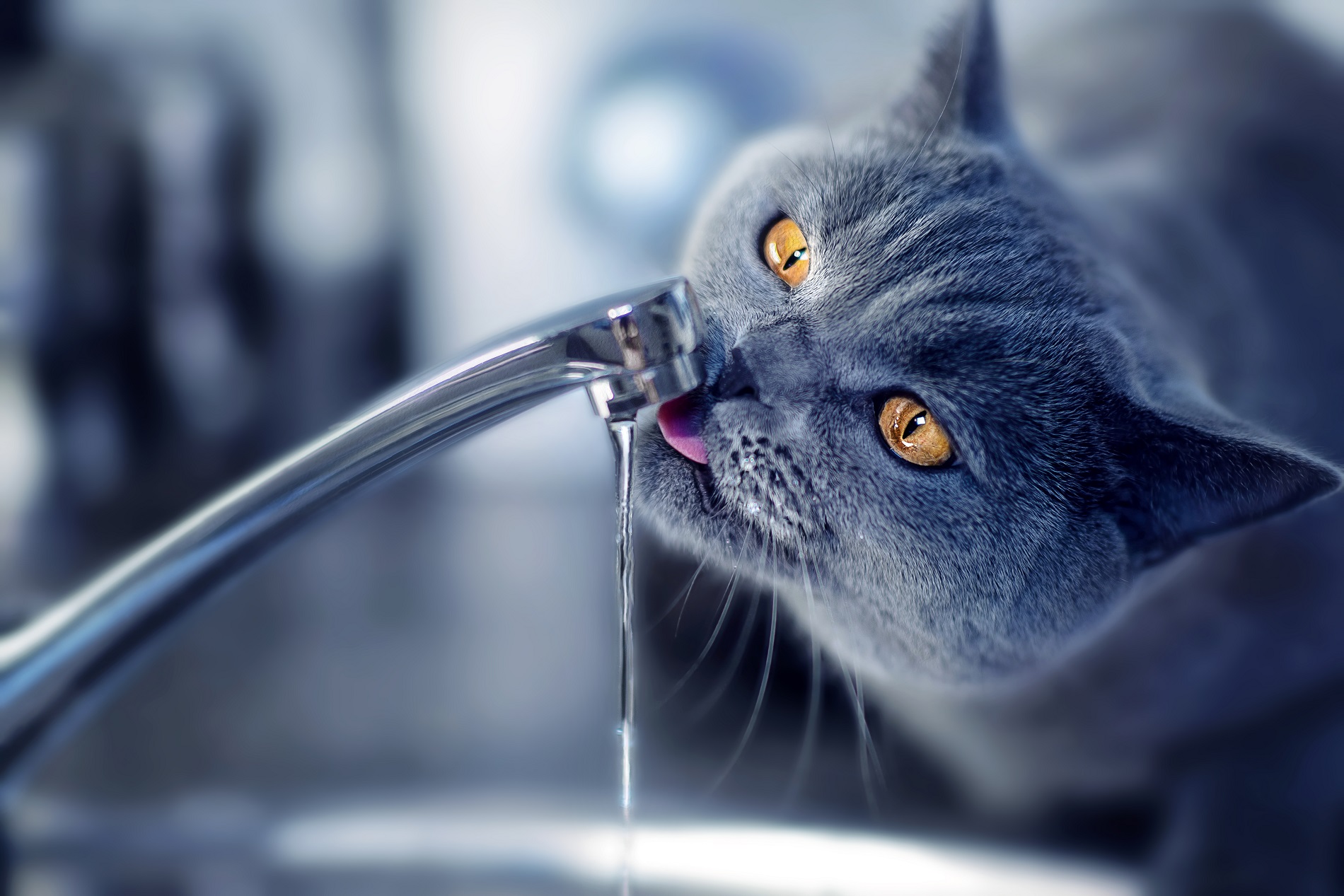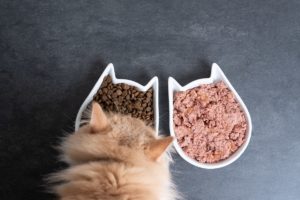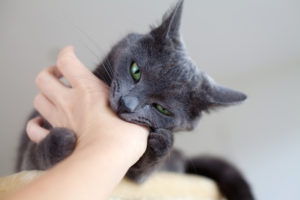Written by: Allison Ward
Kidney disease—also known by the medical term, “renal insufficiency”—is a scary phrase to most cat parents. Unfortunately, kidney problems are a common occurrence as cats age, and can even affect some young cats (though this is much more rare!).
You may be wondering if changes in your cat’s behavior or activity level could be signs of kidney disease. If your cat has already been diagnosed with renal insufficiency, you may be curious as to how you will know if your cat’s kidneys are getting worse over time. Read on to find out more about cat kidneys, and symptoms to watch for that may indicate a problem!
What Do Kidneys Do, Anyway?
Before discussing what signs you may see with kidney disease in cats, it’s helpful to know the basics of what kidneys normally do in the body!
Fluid Regulation and Urine Production
You may remember from biology class that kidneys can be thought of as big filters: they filter out the normal toxins and electrolytes that build up in the bloodstream every day. Not only that, but the kidneys conserve water in the body, and create urine to pee out what the body doesn’t need. How do kidneys decide what to keep and what to eliminate through urine? It’s a very complex process that is too detailed to discuss here—but we’ll give you some basics to help you understand how kidneys work.
In healthy kidneys, deciding how much water to keep in the body and how much water should be lost to urine production depends on whether the cat is dehydrated. When a cat is not drinking much water or has lost fluid through vomiting or diarrhea, then conserving water is a big priority! This is why dehydration leads to less urine in the litterbox in a cat with healthy kidneys.
Another factor in how the kidneys control the amount of urine being produced is how much waste is dissolved in the urine. For instance, if a cat has sugar in her urine due to diabetes, the kidneys put more water into the urine to help flush out the sugar, which creates bigger clumps in the litterbox. The important thing to keep in mind is that when kidneys are damaged or just aging more quickly than the rest of the body, this ability to conserve water is affected—which also leads to more urine in the box, even if the kitty is becoming dehydrated (more on that later).
Regulate Blood Pressure and Red Blood Cell Production
We all know that maintaining normal blood pressure is important to our own health—and it’s just as important to your cat’s health! Blood pressure can be thought of as the force with which blood travels through our veins and arteries, allowing the red blood cells (oxygen-carrying component of blood) to deliver oxygen to vital organs. When blood pressure is too high, tiny microscopic blood vessels can start breaking and bleeding. When blood pressure is too low, then vital organs are not able to get enough oxygen in order to function normally.
Where do the kidneys come into all of this? They are part of a complex system your cat’s body uses to maintain the optimal blood pressure to stay healthy. Your kitty’s kidneys secrete hormones that help regulate blood pressure and contain receptors that serve as a feedback mechanism for the body to keep blood flowing at the perfect pressure. In addition, the kidneys also have millions of fragile, tiny blood vessels that can be damaged by blood pressure that is too high—which means that kidney disease can cause high blood pressure, and high blood pressure can cause kidney disease. It’s a real “which came first, the chicken or the egg?” scenario!
In addition to hormones regulating blood pressure, the kidneys have another essential role in making sure your cat’s internal organs get the oxygen they need. Your cat’s kidneys secrete a special hormone, called erythropoietin, that tells the body to increase red blood cell production. These red blood cells can be thought of as a taxi service that picks up oxygen from the lungs and drops off oxygen to the brain, liver, kidneys, heart, and all of the tissues in your cat’s body. Erythropoietin is like the head of the taxi factory, telling the body to make more. If a cat is in advanced kidney failure, they no longer manufacture enough erythropoietin, and so red blood cells are not made—depriving the tissues of much-needed oxygen.
Symptoms of Kidney Disease in Cats
Now that you are familiar with kidney function and some of the important roles that your cat’s kidneys perform, symptoms of kidney disease will start to make sense.
Increased Thirst and Urination
In the early stages of kidney disease, cat parents often notice their kitties spending more time at the water bowl. Instead of drinking once or twice a day, your cat may be drinking five, six, or more times per day—and seem to be drinking for longer periods of time. You may find yourself refilling the water bowl more often than normal, or finding your cat vocalizing to you because the bowl is empty and they are thirsty! All of that water seems to come out in the litterbox—and you will notice more and larger urine clumps. Since the kidneys are excellent filters, it is not a surprise that more water comes out in urine than usual when the kidneys are not able to do their job appropriately!
Drinking and urinating more frequently can be due to a number of different medical conditions, such as diabetes,—so if you notice these changes, make an appointment with your veterinarian right away. Bloodwork and urine tests will determine if your cat has kidney problems or something else as the cause of his increased thirst and urination.
Vomiting and Decreased Appetite
In cats with kidney disease, normal toxins that are passed out of the body in the urine start to build up in the bloodstream because ailing kidneys cannot filter these toxins out into the urine quickly enough. As these toxins increase in the bloodstream, your kitty will start to become nauseous.
Early on, mild nausea may not be enough to cause vomiting—but it may be just enough to make your kitty queasy at the sight of food and to decrease their appetite. Since vomiting and poor appetite can also be seen with many other causes of cat illness, it’s important to see your veterinarian right away if you notice these changes in your cat.
Weakness and Lethargy
In cats with kidney disease, weakness can happen for a variety of reasons. Your kitty may feel nauseous (see above), or dehydrated from losing so much water through their urine. Also, since the kidneys can’t properly do their filtration work, electrolytes like sodium and potassium may not be regulated properly—too much may be lost into the urine, or too much can build up in the bloodstream. Either way, your kitty won’t feel well and will not be willing to play as usual, or may even be hiding from you and less social than normal.
Blindness
If your cat seems like she is suddenly blind, this could be caused by kidney disease. Signs of sudden blindness in cats include dilated pupils, frantic behavior/panic (just as you would be feeling if you suddenly could not see!), and bumping into objects. How and why could this be related to kidney disease?!
It all comes back to blood pressure! As we discussed, kidney disease can cause high blood pressure, which leads to damage of fragile tiny blood vessels throughout the body. Some of the most fragile blood vessels in the body are in the back of the eye (called the retina), and these vessels are sometimes the first to experience damage and bleeding. If your cat has suddenly developed vision problems, please have her seen by a veterinarian immediately—even if that means taking her to an after-hours clinic. If her blood pressure is high, vision can sometimes be restored with blood pressure-lowering medications—as long as they are started right away!
Seizures or Sudden Loss of Balance
Another area of the body with many fragile, tiny blood vessels is the brain. In cats with high blood pressure, they can experience bleeding of one of these vessels, leading to a stroke. Signs and symptoms of a stroke depend on where in the brain this bleeding occurs, and symptoms will come on very suddenly.
You may see your cat fall to the floor with its legs moving and jerking rapidly for a few seconds (up to a few minutes), or you may see your cat suddenly start to walk like she is drunk and uncoordinated. If you are worried your cat has had a stroke, please have your cat seen by a veterinarian immediately.
What Can Be Done for Kidney Disease?
Although kidney disease can cause many different signs, it’s important to recognize any changes in your cat’s behavior and discuss them with your veterinarian. Your vet can help determine the difference between kidney stones, acute kidney disease, chronic kidney disease, and end-stage kidney failure. A blood test and urine test, as well as imaging of your cat’s kidneys, may be recommended to decide the best way to treat kidney disease if it is present in your cat.
Treatment of kidney disease depends on the underlying cause as well as the severity of kidney damage and what other organs are affected by these changes.
If you have questions about how to treat kidney disease in cats or possible symptoms that you are observing in your cat, please feel free to reach out to our AskVet veterinarians at any time. We are here 24/7 to answer your questions and help you and your kitty have a healthy life together!
Written by:
Allison Ward, DVM
Dr. Allison Ward grew up in the suburbs of Washington, D.C. and started working in veterinary hospitals when she was 14 years old. After graduating from veterinary school in 2011, she completed a small animal rotating internship in New Jersey, followed by a neurology/neurosurgery internship in Miami. After completing this advanced training, Dr. Ward then moved on to general small animal practice. Dr. Ward’s professional interests include feline medicine, neurology, and pain management. Her passion for educating pet owners carries over into her work with AskVet, and she loves being able to help pets and their parents at all times of the day (and night!). She currently resides in sunny south Florida with her two cats, Larry and George.








